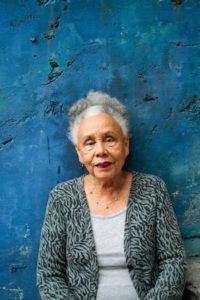
Betye Saar
Betye Saar was born on this date in 1926. She is a Black artist and educator.
Born Betye Irene Nue Brown in Pasadena, CA, Saar studied design at the University of California at Los Angeles (B. A. 1949) and education and printmaking at California State University at Long Beach. In the early 1960s, she created etchings and intaglio, but after seeing a Joseph Cornell show in 1968, she began to expand her work from two to three dimensions, working in the assemblage. She also augmented her mystical and occult themes with challenges to racist myths and stereotypes.
In "The Liberation of Aunt Jemima" (1972), Saar shows a "mammy" doll carrying a broom in one hand and a shotgun in the other in front of repeated images of Aunt Jemima-brand pancake syrup labels. During that period, she also created more personal, nostalgic works, evocatively employing old photographs, gloves, dried flower petals, and other materials.
Saar's works expanded in size and scope in the late 1970s. Her room-size installations frequently included international elements, and she encouraged viewer interaction by inviting others to contribute objects to the work, a practice common in African cultures.
She is noted for collages that lampoon racist attitudes about Blacks and installations featuring mystical themes. Saar also reiterated occult themes with explorations of mysticism in the digital age. Saar's exhibitions included shows at the Whitney Museum of American Art (1975) and the Museum of Contemporary Art in Los Angeles (1984). She collaborated in shows with two of her daughters and taught at the University of California, Los Angeles, and the Parsons-Otis Institute in Los Angeles.
History of African American Artists from 1792 to Present
by Romare Bearden & Harry Henderson
Copyright 1993 by Romare Bearden & Harry Henderson
Pantheon Books, NY
ISBN 0-394-57016-2